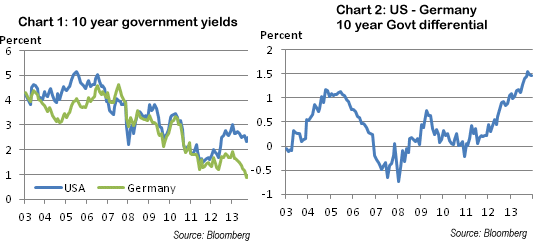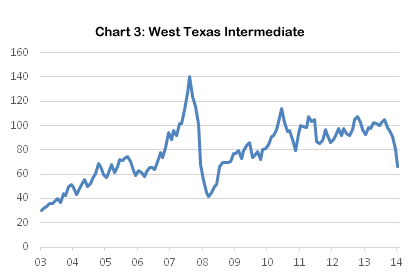Tricky time for investors
Harbour Asset Management director Mark Brown surveys the conflicting economic news across markets and what it means for fixed interest markets.
Thursday, December 18th 2014, 9:29AM
by Harbour Asset Management
Competing forces: The divergence between the US and Europe plus Japan deepens.
For over 12 months there has been increasing evidence that the US economy is on a self-sustained recovery, with healthy growth rates and declining unemployment. In the September quarter GDP grew 1.0% (3.9% annualised, as it is the custom to report in the US) and the unemployment rate fell to 5.8%.
Meanwhile growth in the core European countries ranged from -0.1% in Italy to 0.3% in France. Since the GFC the US has worked through oversupply in the housing market and their financial institutions are in more or less decent shape. Households are more confident, due to a greater sense of job security and the effects of seeing their savings rise in value as equity markets have performed. Much of this has been facilitated by policy action from the Federal Reserve.
Conversely, in Europe growth remains weak. Eurozone unemployment, at 11.5%, has barely improved and confidence is poor. Inflation, at 0.3%, is well below the 2% target level and deflation is a real threat. The ECB managed to overcome the risks posed by Greece in 2011/12, but their limited toolbox, combined with a lack of unity amongst Euro members, has meant a convincing policy solution is still wanting.
In November German 10 year bond yields reached a new low at 0.70%. French, Dutch, Spanish, Italian and Swiss 10 year bond yields all made record lows. In Japan, 10 year yields fell to 0.42%. The gap between US and German 10 year yields is at the highest in some time. (see Chart 2)

This has led to an unusual phenomenon, with US bond yields being dragged down by moves elsewhere. This is a reversal of traditional patterns, where the US Treasury market has been the most influential, typically leading moves across the globe.
Establishing the definitive reason for this change is difficult. We believe this is primarily because European conditions are more symptomatic of broader global conditions. It is also the case that global capital flows are flooding into the US Dollar and US bonds. The US Dollar has been rising and has really become the release valve for global macroeconomic forces.
This has created a difficult environment for investors. With the improvement in the US economy, expectations have been building that the Federal Reserve will be lifting the Fed Funds Rate in 2015. Typically, as the time approaches and the economic data reinforces the likelihood of rate hikes, longer-term bond yields would rise. However the yield on the US 10 year Treasury Note has fallen from 3% to 2.3% so far in 2015.
Looking ahead we anticipate ongoing support for the US Dollar. The actual path of the Fed Funds Rate will be data dependant, but we expect some mild hikes in 2015. This should support the USD as investors bet on further appreciation with the comfort of a positive interest rate differential, compared to the Euro or Japanese Yen. If the ECB and major European governments can also introduce convincing policy initiatives, we would also expect the US bond market to resume its’ primacy.
This would imply rising yields. However until this happens, there is a risk global yields continue to track lower.
Oil Prices plunge
Late in November OPEC surprised the market by deciding not to cut production in the face of falling prices. This caused a further sharp fall in oil futures prices, with the West Texas Intermediate contract down 17.7% for the month. This had a mixed impact on fixed interest markets. Certainly in the near term this is likely to cause inflation data to be lower.
However in theory at least, forward-looking central banks look through oil price impacts, given their historical volatility. Perhaps more relevantly, lower petrol prices immediately benefit households and therefore act as a stimulant to consumer spending. Arguably this offsets the impact the fall in price has on inflation. At a minimum it reinforces the likelihood that the US economy continues with solid momentum.

Australasia: Rate cut speculation in Australia, which may feed across the Tasman
In Australasia, the Reserve Banks do have scope to cut interest rates if required. The Reserve Bank of Australia (RBA) acknowledged this in November, but kept the cash rate at 2.5%, where it has been throughout 2014. Weakening growth, due to the reduction in mining capex as well as broader corporate caution, is raising speculation that the RBA might cut rates.
In New Zealand there has been a fairly rapid shift in tone from the RBNZ, away from the hawkish stance that prevailed through until June. At the September Monetary Policy Statement, a pause was clearly signalled. The fall in annual CPI inflation to 1.0% reinforced this stance.
Now, the further fall in Wholesale Milk Powder (WMP) prices at Fonterra fortnightly auctions, will force Fonterra to reduce their payout forecast for the 2015 year. A fall below $4.50, from last year’s $8.50, is quite possible. As the currency has not kept pace with the decline in the Terms of Trade (brought about by the fall in milk prices), the Reserve Bank will be anticipating a weaker environment. The government’s fiscal position will weaken, farmers will spend less and banks may face some losses if highly geared farmers fail. This is likely to cause the RBNZ to push future rate hikes even further into the future.
We think it is possible that the market takes a lead from Australia and starts to consider the possibility of a rate cut in New Zealand. This is not a base case, but the risk lies in this direction.
The Reserve Bank is unlikely to hint that rate cuts are a possibility. It is the market that may have to take up that mantle.
Market outlook
At the short end of the yield curve, we expect short-term rates to either price no hikes until 2016, or drift into the possibility of cuts in the second half of 2015. The reaction of Fonterra to continued weak WMP auctions will be watched closely.
At the long end of the yield curve, we expect pressure from the changing domestic environment to be reinforced by valuation-driven buying, as NZ Government Stock pricing is attractive for offshore investors at present. However we are also very mindful of the dynamics that could unfold when (and we don’t believe, ‘if’) the US Federal Reserve signal initial hikes in the Fed Funds target rate.
This may mean we see further modest falls in long-term yields before a more aggressive, Fed-driven rise in yields commences. However the scale of any bearish bond market environment is likely to be constrained until European difficulties can be convincingly addressed.
Mark Brown
Director, Fixed Interest Portfolio Manager
Harbour Asset Management
Important disclaimer information: www.harbourasset.co.nz/disclaimer
Harbour research is available at www.harbourasset.co.nz
Important disclaimer information
| « The perfect performance fee: Part 2 | A Review, and a Look Ahead » |
Special Offers
Comments from our readers
No comments yet
Sign In to add your comment
| Printable version | Email to a friend |









